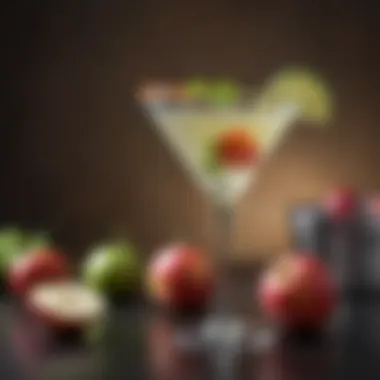Unlocking the Secrets of Appletini Ingredients


Intro
The appletini, a cocktail that exemplifies both style and taste, has garnered popularity over the years. Often found in trendy bars and enjoyed at social gatherings, it is known not just for its delightful flavor but also for its vibrant color. As we dive into the ingredients that make up this iconic drink, we will explore the individual components that contribute to its overall character. Understanding these elements can refine your cocktail-making skills whether you are an amateur mixologist or an experienced bartender.
Recipe Overview
Recipe Name
Appletini
Description of the Dish
The appletini, or apple martini, is a cocktail that combines the refreshing taste of apples with the complexity of spirits. This cocktail generally features a beautiful green hue, making it visually appealing while offering a balance of sweetness and tartness. The appletini is versatile, suitable for various occasions, and can be adapted to personal flavor preferences.
Ingredients
The core ingredients required to create a stellar appletini include:
- 2 ounces vodka
- 1 ounce sour apple schnapps
- 1 ounce apple juice
- ½ ounce fresh lemon juice
- Garnish: apple slice or cherry
Special Notes on Ingredients
- Vodka: Choose a high-quality vodka for a smoother taste. While some prefer to use flavored vodka, classic vodka allows the apple flavors to shine through more distinctly.
- Sour Apple Schnapps: This liqueur is essential for the appletini's signature taste. If unavailable, consider using apple brandy as a substitute, but it may alter the flavor slightly.
- Apple Juice: Fresh apple juice is recommended for a more natural flavor. However, store-bought varieties can suffice in a pinch.
- Fresh Lemon Juice: This ingredient is crucial for balancing the drink’s sweetness. Using fresh lemon juice is paramount; bottled varieties often lack the necessary brightness.
- Garnishes: While the basic garnishes are simply an apple slice or cherry, experimenting with garnishes like mint leaves or edible flowers can enhance presentation.
By examining the ingredients and their individual contributions, one can appreciate the thoughtfulness needed to create a balanced appletini. Each component plays a role in building the drink's overall profile, making the sourcing and quality of ingredients an important aspect of the craft.
Understanding the Appletini
Understanding the appletini is crucial for any mixologist or cocktail enthusiast aiming to create a drink that balances flavor and aesthetics. The appletini, often regarded as a modern classic, combines vodka with apple-flavored liqueur and sometimes fresh apple juice. This section will elucidate its definition, origin, and culinary significance, providing the context necessary for appreciating this cocktail fully.
Definition and Origin
The term appletini is a portmanteau of "apple" and "martini," reflecting its composition and style. Typically, it features vodka as the base spirit, complemented by Apple Pucker or similar fruit liqueurs. The appletini gained popularity in the late 1990s, particularly in the United States, during the wave of cocktail culture that valued visually appealing and flavorful drinks.
Its origins can be traced back to the early days of the cosmopolitan trend, where bartenders experimented with fruit flavors. The appletini became a symbol of this movement, often associated with a youthful and energetic nightlife. Today, variations exist, with fresh ingredients and unique spin-offs gaining traction among aficionados.
Culinary Significance
From a culinary perspective, the appletini is noteworthy for several reasons. Its vibrant apple flavor brings a refreshing quality that appeals to many drinkers. The incorporation of fresh apple juice can create a more complex flavor profile, enhancing the taste experience.
In mixology, the appletini serves as an entry point for individuals new to cocktails, drawing them in with its inviting taste. It exemplifies how a simple combination of ingredients can yield delightful results. Moreover, its colorful presentation makes it a favorite for gatherings, enhancing social interactions while showcasing the art of cocktail crafting.
Ultimately, understanding the appletini involves acknowledging its roots in modern cocktail culture and its role in introducing diverse flavors to novice drinkers. By exploring both its historical context and culinary significance, one gains a richer appreciation for this elegant and enjoyable beverage.
Core Ingredients
The core ingredients of an Appletini are essential to its identity as a cocktail. These ingredients dictate not only the drink's flavor profile but also its overall appeal. Understanding each component helps both novice and seasoned mixologists craft a drink that resonates with its intended audience. Selecting the right proportions and quality of these ingredients can make all the difference in the final result.
Vodka
Selection Criteria
When choosing vodka for an Appletini, purity and smoothness are paramount. Look for products with a high level of distillation, as this minimizes any harsh flavors that may interfere with the cocktail's apple notes. Brands such as Grey Goose and Belvedere are popular choices due to their clean and crisp characteristics.
One key factor to consider is the distillation process. Vodkas distilled multiple times tend to have a more refined taste, contributing positively to the overall outcome of the drink. Choosing a flavored vodka can also be beneficial, so options like Smirnoff Green Apple might enhance the cocktail's apple essence. However, ensure that the added flavors do not overshadow the core ingredients.


Flavor Profiles
The flavor profiles of vodka vary significantly. Neutral vodka works best in an Appletini as it allows the apple flavors to shine. However, some may prefer flavored variations, which can introduce subtle dimensions to the cocktail.
For instance, a vodka with a hint of citrus might provide an unexpected twist. Understanding the unique flavor notes of each vodka can greatly influence how the Appletini tastes. According to many cocktail enthusiasts, the general consensus is that a higher-quality vodka results in a smoother finish, enhancing the drink's enjoyment.
Apple Pucker
Role in Flavor
Apple Pucker, a type of schnapps, is crucial for delivering the signature tartness in an Appletini. It is sweet yet tangy, making it a favored ingredient for cocktails emphasizing apple flavors. This green-apple flavored liqueur adds depth and specificity to the drink, complementing the vodka's smoothness.
One characteristic that makes Apple Pucker favorable is its consistency, as it easily blends with other ingredients. Furthermore, it infuses the cocktail with a vibrant green color, enhancing its visual appeal. Some drinkers appreciate its ability to balance the overall sweetness of the cocktail.
Alternatives
While Apple Pucker is prominent, alternatives like DeKuyper Sour Apple Pucker allow for variations in flavor. These can provide a similar taste but may differ slightly in sweetness or tartness. Other options might include fresh apple juice mixed with a splash of citrus liqueur, allowing for personal twists. This versatility can be advantageous for those with dietary restrictions or a preference for organic ingredients.
Fresh Apple Juice
Juicing Techniques
Juicing fresh apples is an effective way to elevate the quality of an Appletini. Choose organic apples for purity and flavor. Using a juicer can produce a fresh, smooth juice that serves as a perfect addition to the cocktail. Blending and straining can also work, but ensure that the juice is free of pulp for a clean texture.
A juicing technique that many believe is effective involves using a combination of sweet and tart apples, which can present a more balanced flavor in the final drink. This method allows mixologists to control the sugar level, thereby customizing the cocktail precisely to their liking.
Choosing the Right Apples
Choosing the right apples significantly impacts the Appletini's flavor. Varieties such as Granny Smith provide tartness, while Fuji or Gala apples offer sweetness. Using a mix ensures complexity and depth. The freshness of the apples is another aspect that should not be overlooked. Using in-season apples guarantees the best flavor possible.
"The right apple choice can either elevate or undermine the quality of your drink. Choose wisely."
Once the apples are selected, the juicing method should also reflect the intended flavor profile, making sure to align with the overall sweetness and tartness desired in the final Appletini.
Additional Flavor Enhancers
The inclusion of additional flavor enhancers is a crucial element in crafting a well-balanced appletini. These ingredients serve the purpose of enriching the base flavors and providing depth. Each enhancer adds its own unique twist, contributing to the overall complexity of the drink. Utilizing these enhancers smartly can elevate the cocktail from a simple mix to a potent expression of flavor. It is important to choose these ingredients carefully, as they can significantly impact the final taste and aesthetics of the appletini.
Lemon Juice
Balancing Sweetness
Lemon juice plays an essential role in balancing the sweetness of the appletini. When mixed with the sweeter components, like Apple Pucker and simple syrup, lemon juice introduces a necessary tartness. This balance is vital because without it, the drink can become overwhelmingly sweet and lack depth. The bright acidity of lemon juice can uplift the overall flavor profile. Its freshness offers clarity, often making lemon juice a popular choice for cocktails. The unique feature of lemon juice is its ability to act as an equalizer, harmonizing sweet flavors with sour notes. However, using too much can lead to an imbalance, possibly resulting in a drink that is too tart for some palates.
Alternative Acids
Alternative acids can also be explored for enhancing the appletini. While lemon juice is classic, acids like lime juice or even vinegar can provide interesting variations to the taste. Each type of acid brings its own characteristic flavor. For instance, lime juice can impart a more tropical twist, while apple cider vinegar can integrate a more earthy quality. These alternatives can be beneficial choices, as they introduce different dimensions to the drink. However, the challenge lies in knowing how much to use; too much can overpower the intended flavor of the appletini.
Simple Syrup
Making Simple Syrup
Making simple syrup is a straightforward process, yet it is fundamental in achieving the desired sweetness in an appletini. Simple syrup is made by dissolving equal parts sugar in water, typically heated but can also be made cold. This preparation allows for easy incorporation into cocktails without the grainy texture that granulated sugar might introduce. It is a beneficial choice for cocktail crafting because it ensures a smooth blend of flavors. The unique feature of simple syrup is its versatility; it can be flavored with herbs or spices for an added twist, allowing for creative variations. However, careful measurement is necessary, as too much syrup can make the drink cloyingly sweet.
Adjusting Sweetness Levels
Adjusting sweetness levels in cocktails is crucial for personalizing the appletini experience. The process involves adding more or less simple syrup based on individual taste preferences. This adjustment allows flexibility in catering to a wide range of palates. Being able to modify sweet levels can make the appletini inclusive for all drinkers. However, an over-reliance on sweetness can mask the intended flavors of the ingredients. Therefore, balance remains key. When working with sweetness levels, it is vital to taste as you go; this will help in finding the right match for each drinker’s preference and ensuring a delightful cocktail.
Garnishing Options
Garnishing options significantly enhance the aesthetic and flavor profile of an appletini. The choice of garnishes can elevate the cocktail's visual appeal and contribute to the overall drinking experience. An attractive garnish can draw attention and can signify the quality of the drink, while also adding subtle layers of taste that complement the primary flavors.
Sliced Apples


Presentation Techniques
Sliced apples are a classic garnish for the appletini. The technique decides how the slices will be presented. Thin wedges can sit elegantly on the rim of the glass, while larger slices can be fanned out across the surface. This adds a visually appealing touch to the cocktail. The crisp, clean lines of fresh apple slices create a pleasing contrast against the smooth glassware. Furthermore, using a vibrant green apple can tie the visual elements back to the apple-based ingredients in the drink. However, careful attention is necessary to ensure the slices do not brown quickly, which can detract from the freshness and presentation of the drink.
Flavor Impact
The flavor impact of sliced apples in an appletini is notable. The natural sweetness and tartness of fresh apples can enhance the drink's overall profile. This is beneficial as it provides both a textural contrast and a burst of freshness with every sip. Sliced apples can subtly echo the apple pucker and juice used in the cocktail, creating a cohesive experience. However, using apples that are overly sweet or mealy can negatively affect the balance between the drink’s flavors.
Maraschino Cherries
Choosing Quality Brands
Choosing quality brands of maraschino cherries is crucial for ensuring the best garnish. Quality cherries generally have a deeper flavor and vibrant color compared to standard options. This choice can impact both taste and presentation. High-grade brands often use natural ingredients that provide a richer flavor without overpowering the cocktail. While price may be higher, the taste difference can justify the investment in ensuring the garnish complements the overall experience.
Using for Color Contrast
Using maraschino cherries for color contrast can dramatically elevate the appearance of the appletini. The bright red hue provides an attractive contrast against the light green and yellow tones of the drink. This visual pop can grab attention, making the cocktail more enticing. Furthermore, the slight sweetness of the cherry can balance the tartness of the other ingredients. However, reliance on cherries that are not well-suited for cocktails can lead to flavors that clash rather than complement. Therefore, selecting the right type is essential for maintaining the drink's integrity.
Variations on the Appletini
The appletini, though rooted in a particular flavor profile, has taken on numerous adaptations over the years. Variations on the appletini are not just about changing the flavor; they represent the creativity of mixologists and home enthusiasts alike. These adaptations allow for personal expression and cater to diverse palates, thereby broadening the drink's audience.
The significance of exploring variations lies in understanding how small changes can dramatically alter a drink's character. This not only enhances the drinking experience but also makes the appletini more versatile. Different ingredients and preparation methods can bring out unique aspects of the core flavor, offering something new with each rendition.
Caramel Appletini
The caramel appletini is a delightful twist on the classic. This variant introduces caramel flavor, which adds a rich sweetness that balances beautifully with the tartness of apple. Typically, this variation uses caramel syrup or a homemade caramel sauce.
Preparation and Ingredients
- Base Liquor: Vodka is still the primary spirit, retaining the drink's identity.
- Caramel Syrup: Incorporating around half an ounce of caramel syrup helps achieve the desired sweetness. For a more intense flavor, a splash of caramel liqueur can be added.
- Apple Pucker and Juice: The same apple pucker and fresh apple juice are utilized to maintain that familiar appletini essence.
This variant can be garnished with a drizzle of caramel or a slice of apple. The visual appeal of caramel drizzled on the glass enhances its attractiveness, making it a popular choice for parties and winter gatherings.
Green Apple Appletini
The green apple appletini focuses on using green apple flavors to fortify the signature taste of the classic drink. This variation often emphasizes a sharper, more tangy profile.
Key Components
- Green Apple Vodka: A green apple-flavored vodka can be used instead of regular vodka, contributing to a dominant green apple taste.
- Enhanced Tartness: When using apple pucker, opting for a version that is specifically made with green apples intensifies the tartness.
Garnishing with a slice of Granny Smith apple not only complements the flavor but also adds visual appeal. This variant is ideal for those who prefer bolder, tangy flavors over sweeter tastes.
"Variations of the appletini allow for personal expression and a deeper exploration of flavors, transforming a simple cocktail into a canvas for creativity."
By embracing these variations, both enthusiasts and professionals can achieve a broader range of tastes while enjoying the appletini's foundational sweetness and acidity. Whether you revel in the rich notes of caramel or the sharpness of green apples, there’s an appletini variation that can appeal to every type of drinker.
Ingredient Sourcing
Ingredient sourcing is a critical aspect of crafting any cocktail, and the appletini is no exception. The quality of the ingredients directly influences the taste, aesthetic, and overall experience of the drink. Therefore, understanding where to obtain quality ingredients can elevate the cocktail-making process from mundane to extraordinary. This section will dive into sources for two primary components of the appletini: vodka and apple juice, emphasizing what to look for in each.
Where to Buy Quality Vodka


When it comes to vodka, purchasing from reputable suppliers is essential. Here are some factors to consider:
- Brand Reputation: Choose brands like Grey Goose, Ketel One, or Tito’s Handmade Vodka, known for their quality. These brands often maintain strict production standards.
- Local vs. Imported: Some prefer local distilleries for freshness and unique flavors; others might seek the classic characteristics of imported vodka.
- Price Point: While expensive vodka is often better, it isn't always necessary. Price points can range significantly, but opting for mid-range choices usually offers a good balance of quality.
- Tasting Before Buying: If possible, attend tastings or events where you can try different vodkas. This experience informs your decision.
You can find quality vodka at liquor stores, online retailers, or directly from distilleries. Look for reviews and recommendations to guide your selection.
Organic Apple Juice Sources
Using fresh, organic apple juice is vital to achieving a crisp flavor in an appletini. Here’s how you can ensure quality:
- Farmers' Markets: These are excellent places to find fresh, organic apple juice. Vendors often sell fresh-pressed juice without additives.
- Health Food Stores: Stores like Whole Foods often carry organic apple juices. Ensure to check labels for purity and additives.
- Local Orchards: Many orchards offer their products directly to consumers. This not only supports local farms but also guarantees freshness.
- Online Organic Retailers: Websites like Amazon or Thrive Market typically have selections of organic juices. Verify reviews and certifications before purchasing.
Important Tip: Always ask about the process of juicing. Fresh press without preservatives is ideal for optimal flavor experience.
"Selecting quality ingredients not only enhances the flavor of your cocktails but also enriches the entire drinking experience."
Mixing Techniques
In crafting the perfect appletini, mixing techniques play a crucial role. The diverse methods of combining ingredients can significantly influence the cocktail's texture, flavor, and overall presentation. Understanding whether to shake or stir can change the drinking experience entirely. Moreover, serving suggestions add another layer, ensuring your cocktail looks and feels appropriate for any occasion.
Shaking vs Stirring
Shaking and stirring serve different purposes in cocktail preparation. Shaking combines ingredients thoroughly, injecting air into the drink and often creating a frothy texture. This method is particularly useful for cocktails containing juices, like the appletini. The vigorous motion chills the mixture more rapidly, which is often desired for a refreshing beverage.
On the other hand, stirring is a gentler approach, which is traditionally reserved for spirit-forward cocktails. This method maintains the clarity and smoothness of the ingredients, preventing dilution from too much ice melting. For the appletini, shaking is recommended due to its combination of vodka and apple liqueur.
Serving Suggestions
Glassware Options
The choice of glassware is essential for any cocktail, including the appletini. A classic martini glass is often the preferred option. Its wide bowl and narrow neck allow for a beautiful presentation, enhancing the drink’s visual appeal. The shape helps to concentrate the aromas, making each sip more enjoyable. Additionally, using a chilled glass can enhance the tasting experience by keeping the cocktail at the right temperature longer. Glasses like the rimmed cocktail coupe can also serve as stylish alternatives, adding a modern twist to the drink.
- Key characteristics of martini glasses:
- Elegant design for presentation
- Wide bowl enhances aroma
- Chilled glass maintains temperature
The only downside to using a martini glass is its fragility. Care should be taken to avoid accidental spills or breakage, particularly in lively settings.
Temperature Considerations
Temperature is another key element impacting the appletini's enjoyment. Serving the drink cold enhances the refreshing qualities of the cocktail. Both the ingredients, such as vodka and fresh apple juice, and the glass should be chilled prior to mixing. This step ensures the cocktail remains at a pleasant temperature throughout consumption.
- Key characteristics of serving temperature:
- Cold drinks are more refreshing
- Enhances the cocktail's flavor profile
- Prevents quicker dilution from melting ice
If served too warm, the flavors can become muddled, and the refreshing sensation diminishes. Thus, ensuring all components are chilled is essential for the overall success of the appletini.
Ending
The conclusion serves as a critical reflection on the intricate details surrounding the preparation of an appletini. It binds together the myriad components discussed throughout the article, emphasizing their specific roles in crafting a well-balanced cocktail. Through a comprehensive understanding of the key ingredients and techniques, one can appreciate the synergy that defines an exquisite appletini.
Key Elements and Benefits:
- Ingredient Selection: The quality and type of vodka, Apple Pucker, and fresh apple juice significantly influence the final flavor profile. Selecting high-quality ingredients enhances the overall experience by elevating the taste and texture of the drink.
- Mixing Techniques: Knowing whether to shake or stir is crucial. This choice affects the drink's chill and aeration. Mastering these techniques allows for greater control over the cocktail's consistency.
- Enhancement Options: The use of garnishes and additional flavor enhancers, like lemon juice and simple syrup, highlights the appletini’s versatility. Understanding these elements provides opportunities for personalization, ensuring every drink can cater to individual preferences.
Considerations About Conclusion:
The final thoughts on appletini preparation underscore the importance of experimentation and refinement. Both novice and seasoned mixologists can benefit from revisiting the discussed principles. Whether one seeks to impress at a gathering or simply enjoy a drink at home, a deep understanding of the appletini's components will lead to better drink quality and greater satisfaction.
"The art of cocktail making lies not only in following recipes but in understanding how ingredients interact."
This guide, by detailing ingredient sourcing, mixing methodologies, and garnishing techniques, aims to empower the reader. By arming themselves with this knowledge, they can enhance their culinary repertoire, making each appletini a testament to their skill and creativity.







